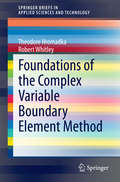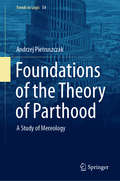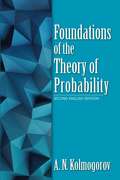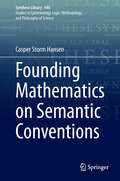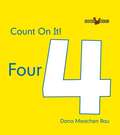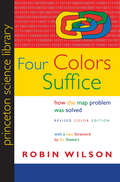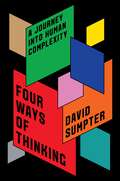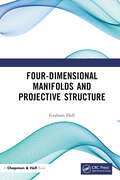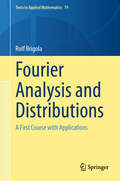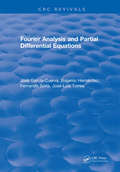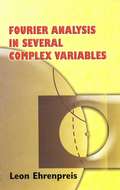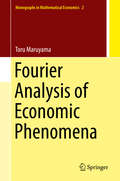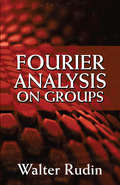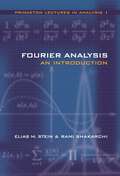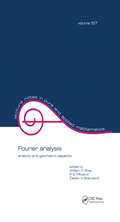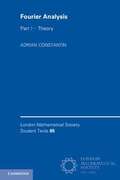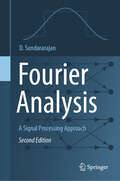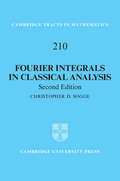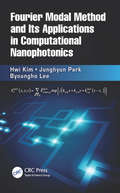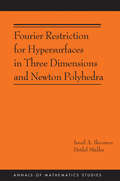- Table View
- List View
Foundations of Wavelet Networks and Applications
by S. Sitharama Iyengar V.V. PhohaTraditionally, neural networks and wavelet theory have been two separate disciplines, taught separately and practiced separately. In recent years the offspring of wavelet theory and neural networks-wavelet networks-have emerged and grown vigorously both in research and applications. Yet the material needed to learn or teach wavelet networks has remained scattered in various research monographs.Foundations of Wavelet Networks and Applications unites these two fields in a comprehensive, integrated presentation of wavelets and neural networks. It begins by building a foundation, including the necessary mathematics. A transitional chapter on recurrent learning then leads to an in-depth look at wavelet networks in practice, examining important applications that include using wavelets as stock market trading advisors, as classifiers in electroencephalographic drug detection, and as predictors of chaotic time series. The final chapter explores concept learning and approximation by wavelet networks.The potential of wavelet networks in engineering, economics, and social science applications is rich and still growing. Foundations of Wavelet Networks and Applications prepares and inspires its readers not only to help ensure that potential is achieved, but also to open new frontiers in research and applications.
Foundations of the Complex Variable Boundary Element Method
by Theodore Hromadka Robert WhitleyThis book explains and examines the theoretical underpinnings of the Complex Variable Boundary Element Method (CVBEM) as applied to higher dimensions, providing the reader with the tools for extending and using the CVBEM in various applications. Relevant mathematics and principles are assembled and the reader is guided through the key topics necessary for an understanding of the development of the CVBEM in both the usual two as well as three or higher dimensions. In addition to this, problems are provided that build upon the material presented. The Complex Variable Boundary Element Method (CVBEM) is an approximation method useful for solving problems involving the Laplace equation in two dimensions. It has been shown to be a useful modelling technique for solving two-dimensional problems involving the Laplace or Poisson equations on arbitrary domains. The CVBEM has recently been extended to 3 or higher spatial dimensions, which enables the precision of the CVBEM in solving the Laplace equation to be now available for multiple dimensions. The mathematical underpinnings of the CVBEM, as well as the extension to higher dimensions, involve several areas of applied and pure mathematics including Banach Spaces, Hilbert Spaces, among other topics. This book is intended for applied mathematics graduate students, engineering students or practitioners, developers of industrial applications involving the Laplace or Poisson equations and developers of computer modelling applications.
Foundations of the Theory of Parthood: A Study of Mereology (Trends in Logic #54)
by Andrzej PietruszczakThis is the first book to systematically study the weak systems of mereology. In its chapters, the author critically analyzes and explains core topics related to mereology, such as parthood without antisymmetry, non-existence of the zero element, and Leśniewski's notion of class and set. The book also delves into three theories of parthood: two concern the sum existence axioms, and the third contends with transitivity of parthood. This is the first systematic analysis of systems of mereology of its kind and is suitable for students, scholars, logicians, and mathematicians who wish to further their knowledge of mereology.Original polish publication “Podstawy teorii części” by The Nicolaus Copernicus University Press
Foundations of the Theory of Probability: Second English Edition (Dover Books on Mathematics)
by A. N. Kolmogorov Nathan MorrisonThis famous little book was first published in German in 1933 and in Russian a few years later, setting forth the axiomatic foundations of modern probability theory and cementing the author's reputation as a leading authority in the field. The distinguished Russian mathematician A. N. Kolmogorov wrote this foundational text, and it remains important both to students beginning a serious study of the topic and to historians of modern mathematics. Suitable as a text for advanced undergraduates and graduate students in mathematics, the treatment begins with an introduction to the elementary theory of probability and infinite probability fields. Subsequent chapters explore random variables, mathematical expectations, and conditional probabilities and mathematical expectations. The book concludes with a chapter on the law of large numbers, an Appendix on zero-or-one in the theory of probability, and detailed bibliographies.
Founding Figures and Commentators in Arabic Mathematics: A History of Arabic Sciences and Mathematics Volume 1 (Culture and Civilization in the Middle East)
by Roshdi RashedIn this unique insight into the history and philosophy of mathematics and science in the mediaeval Arab world, the eminent scholar Roshdi Rashed illuminates the various historical, textual and epistemic threads that underpinned the history of Arabic mathematical and scientific knowledge up to the seventeenth century. The first of five wide-ranging and comprehensive volumes, this book provides a detailed exploration of Arabic mathematics and sciences in the ninth and tenth centuries. Extensive and detailed analyses and annotations support a number of key Arabic texts, which are translated here into English for the first time. In this volume Rashed focuses on the traditions of celebrated polymaths from the ninth and tenth centuries ‘School of Baghdad’ - such as the Banū Mūsā, Thābit ibn Qurra, Ibrāhīm ibn Sinān, Abū Ja´far al-Khāzin, Abū Sahl Wayjan ibn Rustām al-Qūhī - and eleventh-century Andalusian mathematicians like Abū al-Qāsim ibn al-Samh, and al-Mu’taman ibn Hūd. The Archimedean-Apollonian traditions of these polymaths are thematically explored to illustrate the historical and epistemological development of ‘infinitesimal mathematics’ as it became more clearly articulated in the eleventh-century influential legacy of al-Hasan ibn al-Haytham (‘Alhazen’). Contributing to a more informed and balanced understanding of the internal currents of the history of mathematics and the exact sciences in Islam, and of its adaptive interpretation and assimilation in the European context, this fundamental text will appeal to historians of ideas, epistemologists, mathematicians at the most advanced levels of research.
Founding Mathematics on Semantic Conventions (Synthese Library #446)
by Casper Storm HansenThis book presents a new nominalistic philosophy of mathematics: semantic conventionalism. Its central thesis is that mathematics should be founded on the human ability to create language – and specifically, the ability to institute conventions for the truth conditions of sentences.This philosophical stance leads to an alternative way of practicing mathematics: instead of “building” objects out of sets, a mathematician should introduce new syntactical sentence types, together with their truth conditions, as he or she develops a theory.Semantic conventionalism is justified first through criticism of Cantorian set theory, intuitionism, logicism, and predicativism; then on its own terms; and finally, exemplified by a detailed reconstruction of arithmetic and real analysis.Also included is a simple solution to the liar paradox and the other paradoxes that have traditionally been recognized as semantic. And since it is argued that mathematics is semantics, this solution also applies to Russell’s paradox and the other mathematical paradoxes of self-reference.In addition to philosophers who care about the metaphysics and epistemology of mathematics or the paradoxes of self-reference, this book should appeal to mathematicians interested in alternative approaches.
Four (Bookworms Count on It!)
by Dana Meachen RauThe simple and engaging text and photos of Count on It! accomplish two things at once: They teach children how to count as well as to read. The direct correspondence between image and text and consistent format make these books ideal for the beginning reader and mathematician. Other books in this series are available in this library.
Four Colors Suffice: How the Map Problem Was Solved - Revised Color Edition (Princeton Science Library #128)
by Robin WilsonOn October 23, 1852, Professor Augustus De Morgan wrote a letter to a colleague, unaware that he was launching one of the most famous mathematical conundrums in history--one that would confound thousands of puzzlers for more than a century. This is the amazing story of how the "map problem" was solved. The problem posed in the letter came from a former student: What is the least possible number of colors needed to fill in any map (real or invented) so that neighboring counties are always colored differently? This deceptively simple question was of minimal interest to cartographers, who saw little need to limit how many colors they used. But the problem set off a frenzy among professional mathematicians and amateur problem solvers, among them Lewis Carroll, an astronomer, a botanist, an obsessive golfer, the Bishop of London, a man who set his watch only once a year, a California traffic cop, and a bridegroom who spent his honeymoon coloring maps. In their pursuit of the solution, mathematicians painted maps on doughnuts and horseshoes and played with patterned soccer balls and the great rhombicuboctahedron. It would be more than one hundred years (and countless colored maps) later before the result was finally established. Even then, difficult questions remained, and the intricate solution--which involved no fewer than 1,200 hours of computer time--was greeted with as much dismay as enthusiasm. Providing a clear and elegant explanation of the problem and the proof, Robin Wilson tells how a seemingly innocuous question baffled great minds and stimulated exciting mathematics with far-flung applications. This is the entertaining story of those who failed to prove, and those who ultimately did prove, that four colors do indeed suffice to color any map. This new edition features many color illustrations. It also includes a new foreword by Ian Stewart on the importance of the map problem and how it was solved.
Four Lives: A Celebration of Raymond Smullyan
by Raymond M. Smullyan Jason RosenhouseThis "best of" collection of works by Raymond Smullyan features excerpts from his published writings, including logic puzzles, explorations of mathematical logic and paradoxes, retrograde analysis chess problems, jokes and anecdotes, and meditations on the philosophy of religion. In addition, numerous personal tributes salute this celebrated professor, author, and logic scholar who is also a magician and musician.
Four Ways of Thinking: A Journey into Human Complexity
by David SumpterAcclaimed mathematician David Sumpter shares practical and insightful solutions for navigating the chaos and complexity of our livesWhat is the best way to think about the world? How often do we consider how our own thinking might impact the way we approach our daily decisions? Could it help or hinder our relationships, our careers, or even our health? As acclaimed mathematician David Sumpter shows, thinking about thinking is something we rarely do, yet it is something science questions all the time. He has spent decades studying what we could all learn from the mindsets of scientists, and Four Ways of Thinking is the result. Here he reveals the four easily applied approaches to our problems: statistical, interactive, chaotic, and complex. Combining engaging personal experience with practical advice and inspiring tales of groundbreaking scientific pioneers (with a tiny bit of number crunching along the way), Sumpter shows how these tried and tested methods can help us with every conundrum, from how to bicker less with our partners to pitching to a tough crowd—and in doing so, change our lives.
Four Wheels West: A Wyoming Number Book
by Eugene GaglianoUsing numbers, much of Wyoming's history, wildlife, and landscapes are introduced. Topics include two wheel ruts on the Oregon Trail, sugar beets, sheep, and ancient fossil fish.
Four-Dimensional Manifolds and Projective Structure
by Graham HallFour-Dimensional Manifolds and Projective Structure may be considered first as an introduction to differential geometry and, in particular, to 4−dimensional manifolds, and secondly as an introduction to the study of projective structure and projective relatedness in manifolds. The initial chapters mainly cover the elementary aspects of set theory, linear algebra, topology, Euclidean geometry, manifold theory and differential geometry, including the idea of a metric and a connection on a manifold and the concept of curvature. After this, the author dives deeper into 4-dimensional manifolds and, in particular, the positive definite case for the metric. The book also covers Lorentz signature and neutral signature in detail and introduces, and makes use of, the holonomy group of such a manifold for connections associated with metrics of each of these three possible signatures. A brief interlude on some key aspects of geometrical symmetry precedes a detailed description of projective relatedness, that is, the relationship between two symmetric connections (and between their associated metrics) which give rise to the same geodesic paths. Features: Offers a detailed, straightforward discussion of the basic properties of (4-dimensional) manifolds. Introduces holonomy theory, and makes use of it, in a novel manner. Suitable for postgraduates and researchers, including master’s and PhD students.
Fourier Analysis and Hausdorff Dimension
by Pertti MattilaDuring the past two decades there has been active interplay between geometric measure theory and Fourier analysis. This book describes part of that development, concentrating on the relationship between the Fourier transform and Hausdorff dimension. The main topics concern applications of the Fourier transform to geometric problems involving Hausdorff dimension, such as Marstrand type projection theorems and Falconer's distance set problem, and the role of Hausdorff dimension in modern Fourier analysis, especially in Kakeya methods and Fourier restriction phenomena. The discussion includes both classical results and recent developments in the area. The author emphasises partial results of important open problems, for example, Falconer's distance set conjecture, the Kakeya conjecture and the Fourier restriction conjecture. Essentially self-contained, this book is suitable for graduate students and researchers in mathematics.
Fourier Analysis and Distributions: A First Course with Applications (Texts in Applied Mathematics #79)
by Rolf BrigolaThis comprehensive book offers an accessible introduction to Fourier analysis and distribution theory, blending classical mathematical theory with a wide range of practical applications. Designed for undergraduate and beginning Master's students in mathematics and engineering. Key Features: Balanced Approach: The book is structured to include both theoretical and application-based chapters, providing readers with a solid understanding of the fundamentals alongside real-world scenarios. Diverse Applications: Topics include Fourier series, ordinary differential equations, AC circuit calculations, heat and wave equations, digital signal processing, and image compression. These applications demonstrate the versatility of Fourier analysis in solving complex problems in engineering, physics, and computational sciences. Advanced Topics: The text covers convolution theorems, linear filters, the Shannon Sampling Theorem, multi-carrier transmission with OFDM, wavelets, and a first insight into quantum mechanics. It also introduces readers to the finite element method (FEM) and offers an elementary proof of the Malgrange-Ehrenpreis theorem, showcasing advanced concepts in a clear and approachable manner. Practical Insights: Includes a detailed discussion of Hilbert spaces, orthonormal systems, and their applications to topics like the periodic table in chemistry and the structure of water molecules. The book also explores continuous and discrete wavelet transforms, providing insights into modern data compression and denoising techniques. Comprehensive Support: Appendices cover essential theorems in function theory and Lebesgue integration, complete with solutions to exercises, a reference list, and an index. With its focus on practical applications, clear explanations, and a wealth of examples, Fourier Analysis and Distributions bridges the gap between classical theory and modern computational methods. This text will appeal to students and practitioners looking to deepen their understanding of Fourier analysis and its far-reaching implications in science and engineering.
Fourier Analysis and Partial Differential Equations: Proceedings Of The Conference Held At Miraflores De La Sierra, Madrid, Spain (Studies In Advanced Mathematics)
by Jose Garcia-CuervaFourier Analysis and Partial Differential Equations presents the proceedings of the conference held at Miraflores de la Sierra in June 1992. These conferences are held periodically to assess new developments and results in the field. The proceedings are divided into two parts. Four mini-courses present a rich and actual piece of mathematics assuming minimal background from the audience and reaching the frontiers of present-day research. Twenty lectures cover a wide range of data in the fields of Fourier analysis and PDE. This book, representing the fourth conference in the series, is dedicated to the late mathematician Antoni Zygmund, who founded the Chicago School of Fourier Analysis, which had a notable influence in the development of the field and significantly contributed to the flourishing of Fourier analysis in Spain.
Fourier Analysis in Several Complex Variables (Dover Books on Mathematics)
by Leon EhrenpreisSuitable for advanced undergraduates and graduate students, this text develops comparison theorems to establish the fundamentals of Fourier analysis and to illustrate their applications to partial differential equations.The three-part treatment begins by establishing the quotient structure theorem or fundamental principle of Fourier analysis. Topics include the geometric structure of ideals and modules, quantitative estimates, and examples in which the theory can be applied. The second part focuses on applications to partial differential equations and covers the solution of homogeneous and inhomogeneous systems, existence and uniqueness questions related to Cauchy's problem, and boundary value problems for solutions in a cube. The final section explores functions and their role in Fourier representation. Each chapter begins with a detailed summary, and most conclude with general remarks, bibliographical remarks, and problems for further study.
Fourier Analysis of Economic Phenomena (Monographs in Mathematical Economics #2)
by Toru MaruyamaThis is the first monograph that discusses in detail the interactions between Fourier analysis and dynamic economic theories, in particular, business cycles.Many economic theories have analyzed cyclical behaviors of economic variables. In this book, the focus is on a couple of trials: (1) the Kaldor theory and (2) the Slutsky effect. The Kaldor theory tries to explain business fluctuations in terms of nonlinear, 2nd-order ordinary differential equations (ODEs). In order to explain periodic behaviors of a solution, the Hopf-bifurcation theorem frequently plays a key role. Slutsky's idea is to look at the periodic movement as an overlapping effect of random shocks. The Slutsky process is a weakly stationary process, the periodic (or almost periodic) behavior of which can be analyzed by the Bochner theorem. The goal of this book is to give a comprehensive and rigorous justification of these ideas. Therefore, the aim is first to give a complete theory that supports the Hopf theorem and to prove the existence of periodic solutions of ODEs; and second to explain the mathematical structure of the Bochner theorem and its relation to periodic (or almost periodic) behaviors of weakly stationary processes.Although these two targets are the principal ones, a large number of results from Fourier analysis must be prepared in order to reach these goals. The basic concepts and results from classical as well as generalized Fourier analysis are provided in a systematic way.Prospective readers are assumed to have sufficient knowledge of real, complex analysis. However, necessary economic concepts are explained in the text, making this book accessible even to readers without a background in economics.
Fourier Analysis on Groups (Dover Books on Mathematics)
by Walter RudinWritten by a master mathematical expositor, this classic text reflects the results of the intense period of research and development in the area of Fourier analysis in the decade preceding its first publication in 1962. The enduringly relevant treatment is geared toward advanced undergraduate and graduate students and has served as a fundamental resource for more than five decades.The self-contained text opens with an overview of the basic theorems of Fourier analysis and the structure of locally compact Abelian groups. Subsequent chapters explore idempotent measures, homomorphisms of group algebras, measures and Fourier transforms on thin sets, functions of Fourier transforms, closed ideals in L1(G), Fourier analysis on ordered groups, and closed subalgebras of L1(G). Helpful Appendixes contain background information on topology and topological groups, Banach spaces and algebras, and measure theory.
Fourier Analysis: An Introduction
by Elias M. Stein Rami ShakarchiThis first volume, a three-part introduction to the subject, is intended for students with a beginning knowledge of mathematical analysis who are motivated to discover the ideas that shape Fourier analysis. It begins with the simple conviction that Fourier arrived at in the early nineteenth century when studying problems in the physical sciences--that an arbitrary function can be written as an infinite sum of the most basic trigonometric functions. The first part implements this idea in terms of notions of convergence and summability of Fourier series, while highlighting applications such as the isoperimetric inequality and equidistribution. The second part deals with the Fourier transform and its applications to classical partial differential equations and the Radon transform; a clear introduction to the subject serves to avoid technical difficulties. The book closes with Fourier theory for finite abelian groups, which is applied to prime numbers in arithmetic progression. In organizing their exposition, the authors have carefully balanced an emphasis on key conceptual insights against the need to provide the technical underpinnings of rigorous analysis. Students of mathematics, physics, engineering and other sciences will find the theory and applications covered in this volume to be of real interest. The Princeton Lectures in Analysis represents a sustained effort to introduce the core areas of mathematical analysis while also illustrating the organic unity between them. Numerous examples and applications throughout its four planned volumes, of which Fourier Analysis is the first, highlight the far-reaching consequences of certain ideas in analysis to other fields of mathematics and a variety of sciences. Stein and Shakarchi move from an introduction addressing Fourier series and integrals to in-depth considerations of complex analysis; measure and integration theory, and Hilbert spaces; and, finally, further topics such as functional analysis, distributions and elements of probability theory.
Fourier Analysis: Analytic and Geometric Aspects
by William O. Bray; P.S. Milojević; Časlav V. StanojevićProviding complete expository and research papers on the geometric and analytic aspects of Fourier analysis, this work discusses new approaches to classical problems in the theory of trigonometric series, singular integrals/pseudo-differential operators, Fourier analysis on various groups, numerical aspects of Fourier analysis and their applications, wavelets and more.
Fourier Analysis: Part I - Theory
by Adrian ConstantinFourier analysis aims to decompose functions into a superposition of simple trigonometric functions, whose special features can be exploited to isolate specific components into manageable clusters before reassembling the pieces. This two-volume text presents a largely self-contained treatment, comprising not just the major theoretical aspects (Part I) but also exploring links to other areas of mathematics and applications to science and technology (Part II). Following the historical and conceptual genesis, this book (Part I) provides overviews of basic measure theory and functional analysis, with added insight into complex analysis and the theory of distributions. The material is intended for both beginning and advanced graduate students with a thorough knowledge of advanced calculus and linear algebra. Historical notes are provided and topics are illustrated at every stage by examples and exercises, with separate hints and solutions, thus making the exposition useful both as a course textbook and for individual study.
Fourier Analysis—A Signal Processing Approach
by D. SundararajanThis book sheds new light on Transform methods, which dominate the study of linear time-invariant systems in all areas of science and engineering, such as circuit theory, signal/image processing, communications, controls, vibration analysis, remote sensing, biomedical systems, optics, and acoustics. It presents Fourier analysis primarily using physical explanations with waveforms and/or examples, only using mathematical formulations to the extent necessary for its practical use. Intended as a textbook for senior undergraduates and graduate-level Fourier analysis courses in engineering and science departments, and as a supplementary textbook for a variety of application courses in science and engineering, the book is also a valuable reference for anyone – student or professional – specializing in practical applications of Fourier analysis. The prerequisite for reading this book is a sound understanding of calculus, linear algebra, signals and systems, and programming at the undergraduate level. Review of last version “The Fourier analysis is mainly presented from a practical point of view, where the mathematical theory is very simplified. This book is mainly written for broad readership of graduate students and researchers in physics, computer science, and engineering with special interest in signal processing. … Doubtless, this textbook will stimulate the practical education in the Fourier analysis and its applications in signal processing.” (Manfred Tasche, zbMATH 1407.94002, 2019)
Fourier Integrals in Classical Analysis
by Christopher D. SoggeThis advanced monograph is concerned with modern treatments of central problems in harmonic analysis. The main theme of the book is the interplay between ideas used to study the propagation of singularities for the wave equation and their counterparts in classical analysis. In particular, the author uses microlocal analysis to study problems involving maximal functions and Riesz means using the so-called half-wave operator. To keep the treatment self-contained, the author begins with a rapid review of Fourier analysis and also develops the necessary tools from microlocal analysis. This second edition includes two new chapters. The first presents H#65533;rmander's propagation of singularities theorem and uses this to prove the Duistermaat–Guillemin theorem. The second concerns newer results related to the Kakeya conjecture, including the maximal Kakeya estimates obtained by Bourgain and Wolff.
Fourier Modal Method and Its Applications in Computational Nanophotonics
by Hwi Kim Junghyun Park Byoungho LeeMost available books on computational electrodynamics are focused on FDTD, FEM, or other specific technique developed in microwave engineering. In contrast, Fourier Modal Method and Its Applications in Computational Nanophotonics is a complete guide to the principles and detailed mathematics of the up-to-date Fourier modal method of optical analysis. It takes readers through the implementation of MATLAB® codes for practical modeling of well-known and promising nanophotonic structures. The authors also address the limitations of the Fourier modal method.Features Provides a comprehensive guide to the principles, methods, and mathematics of the Fourier modal method Explores the emerging field of computational nanophotonics Presents clear, step-by-step, practical explanations on how to use the Fourier modal method for photonics and nanophotonics applications Includes the necessary MATLAB codes, enabling readers to construct their own code Using this book, graduate students and researchers can learn about nanophotonics simulations through a comprehensive treatment of the mathematics underlying the Fourier modal method and examples of practical problems solved with MATLAB codes.
Fourier Restriction for Hypersurfaces in Three Dimensions and Newton Polyhedra (AM-194)
by Isroil A. Ikromov Detlef MüllerThis is the first book to present a complete characterization of Stein-Tomas type Fourier restriction estimates for large classes of smooth hypersurfaces in three dimensions, including all real-analytic hypersurfaces. The range of Lebesgue spaces for which these estimates are valid is described in terms of Newton polyhedra associated to the given surface.Isroil Ikromov and Detlef Müller begin with Elias M. Stein's concept of Fourier restriction and some relations between the decay of the Fourier transform of the surface measure and Stein-Tomas type restriction estimates. Varchenko's ideas relating Fourier decay to associated Newton polyhedra are briefly explained, particularly the concept of adapted coordinates and the notion of height. It turns out that these classical tools essentially suffice already to treat the case where there exist linear adapted coordinates, and thus Ikromov and Müller concentrate on the remaining case. Here the notion of r-height is introduced, which proves to be the right new concept. They then describe decomposition techniques and related stopping time algorithms that allow to partition the given surface into various pieces, which can eventually be handled by means of oscillatory integral estimates. Different interpolation techniques are presented and used, from complex to more recent real methods by Bak and Seeger.Fourier restriction plays an important role in several fields, in particular in real and harmonic analysis, number theory, and PDEs. This book will interest graduate students and researchers working in such fields.

